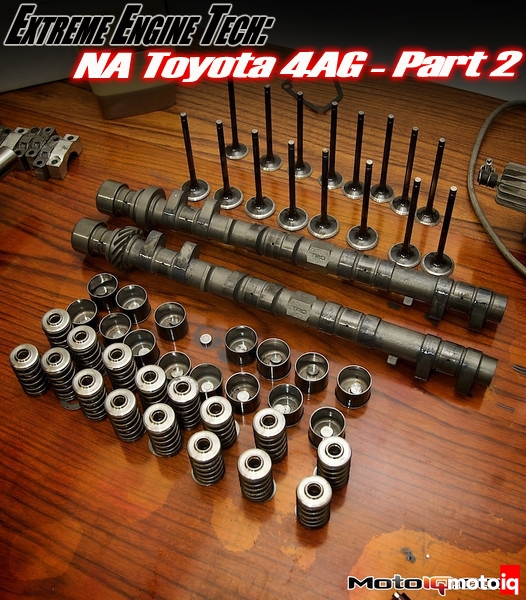
Extreme Engine Tech: Technosquare’s Monster Naturally Aspirated Toyota 4AG – Part 2
by Mike Kojima
In our last edition of the building of Technosquare’s monster Toyota 4AG, we mainly looked at the details of the bottom end. Now we will finish our tour of the bottom end and delve into the engine’s cylinder head which is the heart of any high performance engine.
The 83mm x 83 mm stroker motor gives 1800cc. The 200 extra cc’s makes a huge difference, fortifying the 4AG’s notoriously narrow power band. The engine cranks out over 250 crank hp, more than the most highly developed Formula Atlantic engines of yore and 30 more hp than the previous 1600 cc version of this motor. On a Dynopack chassis dyno the 4AG ripped out 216 whp, a hell of a lot for a naturally aspirated 4AG. You have to remember that a RWD set up typically robs 20% from the crank power levels vs the 15% more efficient FWD transaxles typically steal.
 |
Wiseco forged pistons are used. To maintain the best possible stroke to rod length ratio, the pin is moved as high in the rod as possible. It even intrudes into the oil ring groove slightly. Strut type construction is used for light weight. The skirts are moly coated for less friction and better wear of the skirts and cylinder walls. The dome volume is set to give a 13:1 compression ratio. Technosquare deburrs and cleans the dome of all sharp edges which could result in hot spot causing detonation. The pistons feature double pin oilers and use a tapered wall lightweight 20mm tool steel piston pin for minimal weight. This is the post 1988 4AG pin diameter, up 2mm from the older, weaker, flexy 18mm pins. The pin is retained with Cosworth style round wire retainers. |
 |
This close up shot shows the radical pin placement, intruding into the oil ring groove. This sort of design usually has higher oil consumption but allows the longest possible connecting rod for an improved rod ratio and lower piston speed. The piston has anti detonation grooves between the top of the piston and the top ring. These grooves buffer the detonation shock waves and protect the top ring. The also reduce the contact area high on the piston for less friction. The grooves also reduce expansion at the top of the piston to reduce the likelihood of scuffing under extreme heat. A pressure equalization groove between the compression rings improve ring seal at high rpm by acting like a reservoir for leaking combustion gasses, improving the seal of the second ring. |
 |
The rings are fairly conventional. The upper compression ring is a narrow 1mm chrome face design. The second compression ring is a 1.2 mm iron ring. Both rings are low tension for reduced friction and less likelihood of flutter at high rpm. The oil ring is a conventional 2 rail design. |
 |
The stock 4AG valvetrain uses shim on bucket valve adjustment. This system has trouble at over 8000 rpm and 8.5mm of lift. The cam lobes tend to flip the valve shim off of the top of the cam follower. When this happens the cam lobe beats on the retainer and causes the keepers to fall out and the valve to drop, destroying the engine. To prevent this from happening the valve train is converted to TRD Formula Atlantic stuff. Double valve springs are used with titanium retainers that are designed to accept a small adjusting shim. The cam follower goes over the shim preventing it from getting flicked out by the cam lobe. You can see one of the small adjusting shims next to the cam followers. This is called a shim under bucket system and is used in motorcycle and other high RPM engines. TRD big valves are used, they are 2mm bigger than stock. TRD Formula Atlantic cams are also used, 320 degrees intake duration and 304 degrees exhaust duration. Both cams have 11mm of valve lift. The cams are set on a 102 degree lobe center. |



